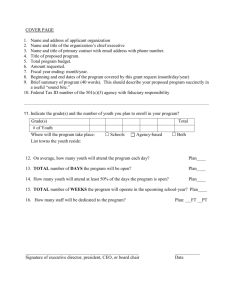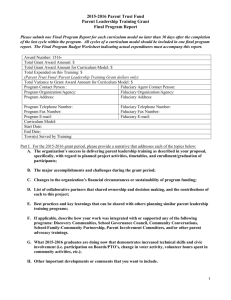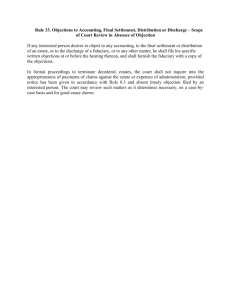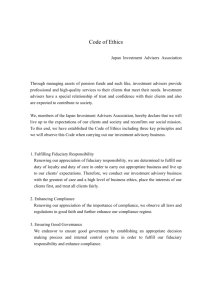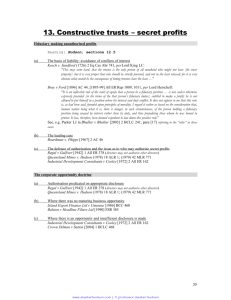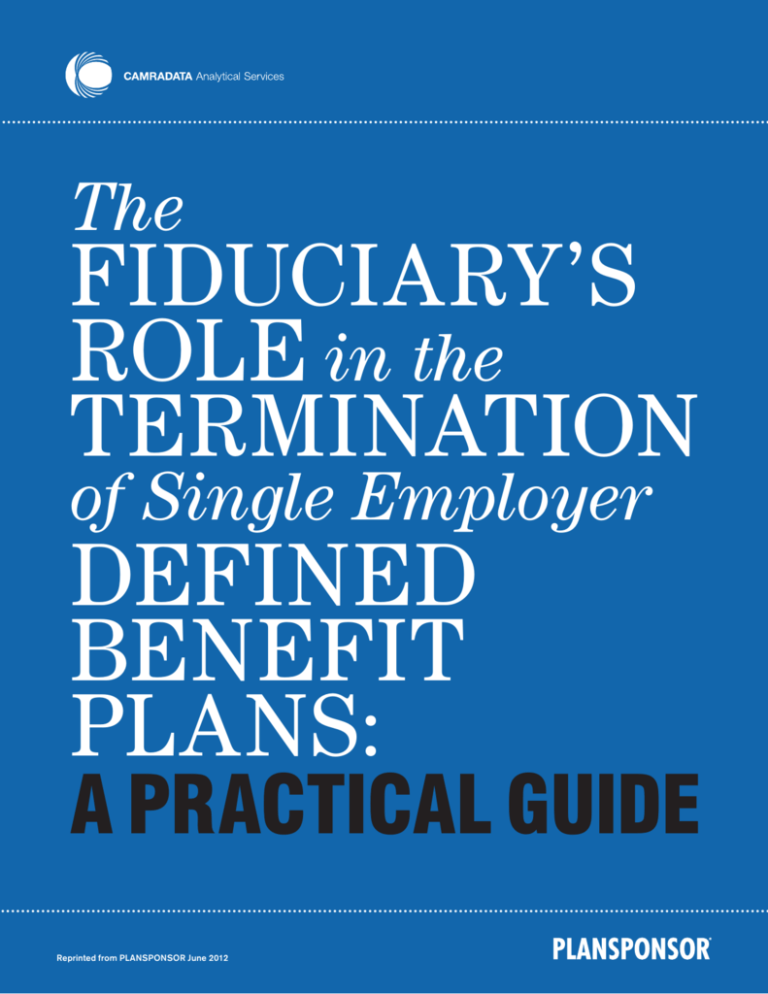
The
FIDUCIARY’S
ROLE in the
TERMINATION
of Single Employer
DEFINED
BENEFIT
PLANS:
A PRACTICAL GUIDE
Reprinted from PLANSPONSOR June 2012
INTRODUCTION: WHY YOU SHOULD
READ THIS ARTICLE
De-risking their defined benefit pension plans has become
the imperative goal of most plan sponsors. While de-risking
takes many forms, the gold standard is termination of the
plan and transfer of its liabilities to an insurer by purchase
of a buy-out annuity contract.
Once the plan sponsor has decided to terminate the
plan, the fiduciary is responsible for implementing the
termination in compliance with ERISA and other law. The
fiduciary’s challenge arises from the structural tension
between the fiduciary’s ERISA obligations to act only in
the best interests of the plan’s participants, and the plan
sponsor’s legitimate business goals. The sponsor wants
the termination to be cost-effective and swiftly executed
within the sponsor’s target interest-rate window. But
the fiduciary’s obligation under ERISA is for prudent
selection of the buy-out annuity — according to the Labor
Department, the “safest available” annuity — under a
rigid timetable fixed by law and regulated by multiple
government agencies. To resolve the tension between
these competing goals, to bring the termination to a
successful close as efficiently as possible, and to avoid even
a perceived conflict of interest, the fiduciary must have a
carefully crafted and well thought out fiduciary process.
The fiduciary is personally liable for any imprudent annuity
selection. But the in-house fiduciary is typically broadly
indemnified by the plan sponsor. A defective fiduciary
process thus can leave both the in-house fiduciary and the
plan sponsor contingently exposed to plan liabilities for up
to six years after the annuity purchase, and even longer in
the case of fraud or concealment.
Part I of this article sets forth a checklist of plan sponsor
and fiduciary action. Part II expands on the fiduciary’s risks
and responsibilities in bringing the termination to a close.
B. Fiduciary Checklist
(1) Create the fiduciary structure
• Determine identity and composition of in-house fiduciary
• Decide whether to retain independent fiduciary, and if so,
in what role
• Retain annuity placement advisor and other independent
experts (federal tax and securities law, ERISA, state
insurance law, actuarial, insurance industry expertise)
• Negotiate and execute compensation, indemnification
and confidentiality agreements of all outside advisors and
fiduciaries
• Establish communication protocols between fiduciary and
corporate officers
(2) Select the annuity provider
• I nitiate and schedule fiduciary deliberation of factors
listed in the Labor Department’s Interpretive Bulletin
(IB) 95-1 for prudent selection of annuity provider, and
determine meaning of “safest available annuity provider”
standard
• I nitiate and complete data cleanup
• I nitiate and review annuity advisor’s list of selected
annuity providers
• Conduct request for preliminary annuity proposals
• Review proposals and resolve any issues with annuity
providers
• Obtain final bids on the basis of preliminary proposals
• Select annuity provider
(3) De-risk plan asset portfolio
• Devise investment strategy, including transition portfolio
• I nitiate and complete orderly disposition of illiquid and
hard-to-value assets
(4) Furnish all required government filings and participant
notifications
I. CHECKLISTS
A. Plan Sponsor Checklist
• Retain annuity placement advisor to determine price point
for cost effective termination
• Decide whether to add lump sum distribution options, and
for which groups
Reprinted from PLANSPONSOR June 2012
• Amend plan to freeze benefits
• Determine appropriate funding strategy
• I nitiate termination (entire plan, or retiree liabilities only,
in “spin-off termination”)
• Submit required Pension Benefit Guaranty Corporation
(PBGC) filings according to PBGC timetable
• F ile for IRS determination letter, including submission
of required plan amendments
• Submit any required filings to state insurance
commissioners
SPONSORED SECTION
• F urnish all required notices to participants and
beneficiaries (notice of intent to terminate [NOIT];
204(h) notice of plan freeze, notice of plan benefits, etc.)
(5) Implement lump sum or other design amendments
• Ensure that all benefit elections observe requirements
of Internal Revenue Code and ERISA
(6) Extra steps for spin-off termination
• Determine responsibilities for splitting assets between
ongoing plan for active participants and terminated spinoff
plan for retired participants
II. THE FIDUCIARY’S ROLE
IN A PLAN TERMINATION
The ERISA Framework and Its Challenge
The decision to terminate the plan is made by the plan
sponsor. The plan sponsor’s decision to terminate is a
“settlor” act. This means it is not governed by ERISA’s
fiduciary obligations and is not subject to fiduciary review.
The decision may thus be made solely on the basis of
financial and other business considerations. In practice,
the plan sponsor will decide to terminate its plan only after
obtaining information about buyouts and monitoring their
pricing either from an annuity advisor or from commercial
databases and other information sources.
The plan sponsor may decide to terminate the entire plan, or
instead only the retiree liabilities in a spinoff-termination. In
addition, the sponsor may decide to add a lump sum option,
possibly including a lump sum for retirees in pay status.
A high lump sum take rate before the termination will of
course reduce the size of the annuity purchase. Moreover,
the 2006 Pension Protection Act (PPA) allows lump sums to
be valued using corporate bond interest rates, rather than
the Treasury bond rate formerly required, making lump
sums relatively less costly to the plan. Like any other benefit
design change, adding a lump sum is a settlor decision and
therefore may be made solely for the purpose of reducing
the cost of the termination.
Even though it is a settlor decision by the plan sponsor to add
a lump sum, it does add pressure to the fiduciary’s task. The
decision gives participants a one-time choice between a lump
sum and an annuity, contingent on the long-term financial
health of the issuer. Any such election is a potential invitation
Reprinted from PLANSPONSOR June 2012
to later litigation by regretful participants. The fiduciary
may have to take extra care to ensure that participant
communications could in no way be viewed as encouraging
the selection of one over the other, or as misstating or
concealing relevant facts, and that elections are safeguarded
with adequate information for informed participant choice.
Once these settlor decisions have been made, the fiduciary
must implement them.
One head, two hats. ERISA’s well known “two hat”
doctrine allows an agent or employee of the plan sponsor
to act as plan fiduciary. But when acting in its fiduciary
capacity, the employee must act solely in the interests of
plan participants. While incidental benefit to the sponsor is
not prohibited, the fiduciary’s deliberations may not take the
plan sponsor’s interests into account, but only those of the
plan’s participants and beneficiaries.
We have noted that in the case of a plan termination,
potential tension exists between the plan sponsor’s interests
in a cost-effective annuity and the participants’ interests in
the safest available annuity. When such potentially divergent
interests exist, the fiduciary has the duty to ensure that its
decision is not conflicted, and indeed is not even perceived
as conflicted.
Ensuring loyalty, independence, prudence and care.
Several means have evolved by which the potentially
conflicted fiduciary can establish that its decision was
not influenced by the interests of the plan sponsor. These
include (1) an intensive and independent investigation and
decision-making process; (2) retention of an independent
fiduciary; and (3) establishment of protocols governing
communications between the fiduciary and the sponsor’s
financial decision makers.
The first of these — an intensive and independent
investigation — is absolutely necessary, and its
importance cannot be overstated. Both prongs are key.
The fiduciary’s “intensive” investigation must include
thorough deliberations of all issues with the assistance
of qualified experts. The fiduciary must make its decision
independently of any influence of the plan sponsor’s
business interests. The good news for the fiduciary is
that the fiduciary process to create an “intensive” and
“independent” investigation needed to show non-conflicted
decision making is also the process needed to show the
fiduciary met its ERISA duties of ­prudence and care.
SPONSORED SECTION
Showing how the fiduciary can build this process,
for the purpose of ensuring that the fiduciary has
met its duties of loyalty, independence, prudence
and care, is the task of this article.
or indirect — for effectuating the termination, or meeting
any price point or deadline. Such incentives might well be
viewed as tainting the fiduciary’s independence to a degree
not salvageable even by careful process.
Process may be scaled to size. A practical question exists
about how complex an apparatus is advisable to establish
the fiduciary’s independence and undivided loyalty. In the
termination of a small or medium plan, where a safe annuity
can be obtained with normal degrees of fiduciary prudence
and care, less process may be thought necessary. But in
a large termination involving billions or tens of billions
of dollars of liability, the annuity purchase puts more
pressure on the capacity of any one insurer, is more open to
challenge, and may well be harder to defend as adequately
safe given the size of the transferred liabilities relative to
insurance industry capacity. Some experts estimate that
the capacity of the leading insurers is currently perhaps
not more than $80 billion. When interest rates and asset
values converge to make terminations more attractive, and
multiple sponsors compete for annuities, these very large
terminations will put pressure on industry capacity and any
annuity selection will be closely scrutinized for its adequacy
by participants and perhaps the Labor Department. And
as a reality of today’s legal environment, the acts of large
plan sponsors are more likely to be the target of class action
lawsuits. In such a mega-termination, the fiduciary may
want to create a robust process using extensive measures
to demonstrate that the decision met the highest possible
standards of prudence, care and independence from the
business interests of the plan sponsor.
Independent experts. To fulfill its duties of loyalty,
prudence and care, the fiduciary needs to tap expertise in
several areas. In IB 95-1, the Labor Department takes the
position that the fiduciary implementing a termination need
not hire outside experts to the extent the fiduciary has the
requisite expertise. This is rare. Typically, the fiduciary
will at the least retain an annuity advisor. Additional
independent expertise may be needed in ERISA, tax law,
securities law, state insurance law, actuarial practice, and
the economics and structure of the insurance industry.
(1) CREATE THE FIDUCIARY STRUCTURE
The in-house fiduciary. The first step is to decide the
identity of the in-house fiduciary. A large or complex
defined benefit plan may have two fiduciaries: the plan
administrator (typically a committee) and an investment
committee, generally comprised of the sponsor’s financial
officers. It must be decided which of the two is the acting
fiduciary — that is, the ultimate decision maker with respect
to selection of the buy-out annuity. If instead it is decided
that an independent fiduciary will be the acting fiduciary (as
discussed below), it should be decided which of the in-house
fiduciaries will be responsible for selecting the independent
fiduciary. Selecting the independent fiduciary is itself a
fiduciary decision. Each fiduciary’s compensation should be
reviewed to ensure that it provides no incentives — direct
Reprinted from PLANSPONSOR June 2012
The fiduciary should build in the time necessary to negotiate
its advisors’ agreements for compensation, indemnification
and confidentiality — all key in a transaction with high
dollar exposure and high employee sensitivity.
Independent fiduciary. When the in-house fiduciary is
potentially conflicted with respect to a transaction, the
Labor Department favors hiring an independent fiduciary
to make or advise on the decision. In IB-95-1, the Labor
Department takes the position that an independent fiduciary
may be required for termination of an overfunded plan
where the possibility of reversion exists. In today’s economic
climate, such cases are vanishingly rare. But the same
tension exists even in termination of an underfunded plan.
The potential conflict between the plan sponsor’s interest in
minimizing top-up funding contributions and participants’
interests in a safe annuity is governed by the duty of
loyalty, as is recognized by IB 95-1. Therefore, selecting an
independent fiduciary may be desired in all cases.
An independent fiduciary can serve in many kinds of
capacities — as advisory fiduciary, acting fiduciary, or
co-acting fiduciary. In some cases, the annuity advisor may
be willing to acknowledge fiduciary status in an advisory
capacity much like an investment advisor. Alternatively,
an independent fiduciary may be retained as the acting
fiduciary. General Motors, for example, has stated that the
selection of Prudential as its buy-out annuity provider was
made by an independent third-party fiduciary. Another
commonly used model is to have the independent fiduciary
act as a co-decision maker, with effective veto power over
the decisions of the acting in-house fiduciary.
SPONSORED SECTION
Communications protocol. The fiduciary should create
a protocol governing communications between the plan
sponsor’s corporate and financial personnel and their
advisors, and the fiduciary and its advisors. Rules governing
the content and means of communication will help create a
record that the fiduciary’s deliberations were independent of
the plan sponsor’s business interests. This may be especially
advisable where the in-house fiduciary, rather than an
independent fiduciary, is the acting fiduciary responsible for
selecting the buy-out annuity.
communications between these overlapping sets of advisors.
Maintaining perceived independence is helpful for both
fiduciary and non-fiduciary personnel alike. The fiduciary
cannot show it met its duties of prudence, care and loyalty
untainted by conflict unless it can show deliberations were
independent. And if the sponsor’s non-fiduciary business
decision makers are viewed as controlling the process, they
may be viewed as de facto ERISA fiduciaries. As perceived or
de facto fiduciaries, their decisions are subject to challenge
for ERISA fiduciary breach, and they themselves are subject
to personal liability for resulting damages. The case law
abounds with such examples. Some show obvious control,
such as a memo sent from a company officer directing the
fiduciary on how to act. But more subtle examples involve
individuals who were held to be the acting fiduciary merely
because they briefed the fiduciary committee or participated
in its deliberations with no voting role.
Selecting the annuity provider is the fiduciary’s most
important decision in implementing the termination.
The protocol will depend on what kind of fiduciary
structure the in-house fiduciary has decided to create.
The fiduciary committee typically contains financial
personnel closely involved with the sponsor’s business
interests. At a minimum, rules should govern the content
of communications between these individuals and the
sponsor’s non-fiduciary business decision makers about the
termination and annuity selection.
In a very large termination where the in-house fiduciary
may have decided to create a particularly robust process,
more thought will be needed. The plan sponsor’s business
decision makers almost certainly decided to terminate the
plan only after conducting their own investigation with the
assistance of an outside annuity advisor and consulting their
own counsel. These same decision makers will probably keep
an eye on the process to ensure the termination remains
cost-effective. The in-house fiduciary desiring to show
maximum independence may have decided to retain its
own parallel, but independent, set of advisors and counsel.
The fiduciary must plan for how to coordinate and manage
Reprinted from PLANSPONSOR June 2012
Decision-making record. Longstanding case law has
established that the fiduciary is not permitted to rely
“blindly” on the advice of its independent experts. To show
that it evaluated the experts’ advice, and reached its opinions
independently, the fiduciary should have a system for keeping
records of deliberations leading to those decisions.
(2) SELECT THE ANNUITY PROVIDER
Applicable standard. In IB-95-1, the Labor Department
takes the position that the fiduciary must select the “safest
available” annuity, unless the participants’ interests would
clearly be served otherwise. Only two examples are named
of acceptable annuities that are not the “safest available”:
where the safest annuity provider is unable to process
claims, and where the safest annuity is only “marginally”
safer and disproportionally more expensive, and the
participants benefit from the price difference in the form of
enhanced annuities.
The “safest available” standard turns on the objective safety
of the annuity, rather than ERISA’s longstanding concern
for procedural soundness. For this reason, the standard has
been rejected by the only two federal courts of appeal to
consider it, in favor of the general process-oriented standard
of care, prudence and loyalty governing other ERISA
fiduciary decisions.
Nonetheless, the procedural steps outlined in IB 95-1 have
been embraced by the case law as consistent with the fiduciary’s ERISA duties, and should be followed. IB 95-1 states
that, in selecting the annuity, the fiduciary is not permitted
to rely solely on ratings by insurance ratings services. Rather
the fiduciary must evaluate the soundness of the annuity on
the basis of at least six factors: (1) quality and diversification
of annuity provider’s investment portfolio; (2) size of insurer
relative to proposed contract; (3) level of insurer’s capital and
surplus; (4) annuity provider’s exposure to liability from its
other lines of business; (5) structure of the annuity contract
and guarantees supporting the annuities, such as the use of
separate accounts; (6) availability of additional protection
through state guarantee agencies. In addition to safety and
soundness of the annuity, the fiduciary must also take into
account the ability of the provider to process claims.
SPONSORED SECTION
For a number of these factors, their weight and impact on the
fiduciary’s decision will depend on the size of the termination.
Size of insurer relative to proposed contract. For
a very large termination, involving billions of dollars,
insurance industry capacity may be a significant concern.
The fiduciary in this case might want to consider possible
ways of spreading the risk among multiple insurers. Possible
options include purchase of commercial longevity insurance
and creation of a syndicate of multiple insurers, each of
whom would insure a piece of the contract. None of these is
mentioned in IB 95-1, but may be viewed as related to the
fiduciary’s duty under IB 95-1 to evaluate insurer capacity
relative to plan size.
Structure of the annuity. A separate account allows
assets dedicated to the annuity contract to be walled
off from claimants to the insurer’s general account. It is
typically structured so that the insurer’s general account
guarantees the benefit payments under the contract. A
separate account may be unavailable for a small plan, and is
generally more costly than a regular annuity contract.
State guarantee associations. For a very large
termination, the existence of state guarantee associations
may not be a significant factor. The protection offered by
guaranty associations flows solely from their legal authority
to make assessments on their member insurers; claimants
have no recourse to the general funds of the state. In most
(or possibly all) states, the dollar amount of assessments is
capped at 1% or 2% of annual premiums written or received
in the state. Insolvency of a large insurer would significantly
impair the ability of the guaranty association to meet its
obligations. Moreover, in some states, statutory dollar caps
may limit the guaranty fund’s liability, or its liability for any
one insurer or any one contract.
Can cost be a factor? As a practical matter, most annuity
advisors will include annuity cost as a factor in evaluating
preliminary and final bids. When is the fiduciary permitted
to consider an annuity’s cost? At least one federal court of
appeals has said that cost is a permitted factor but only after
the fiduciary has first determined that the annuity providers
are “comparable.” IB 95-1 states that there may be “more
than one safest available annuity.” While not entirely clear,
it may be inferred that the Labor Department acknowledges
that a group of equally acceptable annuity providers may
exist and that, within this group, cost can be a tie-breaker.
Reprinted from PLANSPONSOR June 2012
Data cleanup. Participant census and benefit data must
be updated before the request for preliminary bids is
submitted to potential annuity providers. Without good
data, an accurate cost estimate is impossible. Accurate
census data also is required to prepare the Notices of Plan
Benefits that must be provided to each plan participant as
part of the PBGC plan termination procedure. This task
should be started as soon as possible, since old data may
be stored on outdated systems and media, making cleanup
costly and time consuming.
Request for preliminary proposals. When insurers
submit their final annuity bids in response to the fiduciary’s
request for proposal (RFP), the fiduciary typically has a
window of only a few hours to accept. Therefore, a prior
request for preliminary proposals is essential. Insurers’
nonbinding preliminary proposals allow the annuity advisor
to narrow its field of intensive evaluation to that subset of
insurers who respond to the preliminary request. On the
basis of this intensive evaluation — which typically takes
weeks — the fiduciary can make a determination of likely
annuity providers, and can make any needed changes in the
final request for bids.
Request for final bids and selection of annuity
provider. When final bids are solicited, the fiduciary, with
the assistance of its annuity advisor, will select the annuity
provider and subsequently transfer assets as a single
premium to pay for the contract.
(3) DE-RISK PLAN ASSET PORTFOLIO
The plan’s investment portfolio will probably need to be
transitioned to lower risk, more liquid assets in anticipation
of the pending annuity purchase. If the plan has a written
investment policy, the fiduciary should amend it accordingly.
The fiduciary should initiate and complete orderly
disposition of illiquid and hard-to-value assets. Some of
these may be difficult to transfer to a third-party buyer
at an acceptable price. If an asset’s book value exceeds its
fair market value, the plan sponsor may purchase the asset
directly from the plan — without triggering the otherwise
“prohibited transaction” penalties that would apply —
provided that the sponsor follows the terms of PTE 2002-51.
The sponsor is permitted to take a deduction for the deemed
“contribution” equal to the excess of the asset’s book value
over its fair market value.
SPONSORED SECTION
(4) FURNISH ALL REQUIRED GOVERNMENT
­FILINGS AND PARTICIPANT NOTIFICATIONS
The termination is subject to multiple notice, filing and
other requirements imposed by the PBGC and Internal
Revenue Service, and, in some cases, the state insurance
commissioner.
PBGC Requirements
•C
ommence search for missing participants. If a participant
or beneficiary cannot be found after a “diligent search,”
the plan must either purchase an annuity from a private
insurer in that person’s name and provide information on
the missing person and insurer to the PBGC, or transfer
the value of the person’s benefit to the PBGC’s Missing
Participants Program
•N
otice of Intent to Terminate provided to affected parties
at least 60 but not more than 90 days before proposed
termination date
•S
tandard Termination Notice (Form 500) filed with PBGC
no later than 180 days after proposed termination date
•N
otice of Plan Benefits furnished to participants,
specifying the amount and form of each participant’s plan
benefits, no later than Standard Termination Notice filed
with PBGC
•N
otice of Annuity Information furnished to affected parties
at least 45 days before the asset distribution date
•A
sset Distribution Date completed by later of (i) 180 days
after the expiration of the PBGC’s 60-day review period
for the Standard Termination Notice, or (ii) 120 days after
the plan receives a favorable determination letter from the
IRS provided the determination letter was requested by the
time the PBGC Form 500 was filed
•N
otice of Annuity Contract furnished to participants and
beneficiaries receiving benefits in the form of an annuity
within 30 days after plan assets are distributed
•P
ost Distribution Certification (PBGC Form 501) filed with
PBGC within 30 days after the last distribution date for any
affected party
IRS Requirements
•N
otice of benefit freeze [204(h) Notice] provided to
participants within IRS’s required window before the
effective date of the amendment
•N
otice to Interested Parties posted no more than 24 days
and no less than 10 days before the filing with the IRS of an
application for a determination letter
Reprinted from PLANSPONSOR June 2012
• Determination Letter Request (IRS Form 5310) filed with
IRS no later than Form 500 filed with PBGC; IRS will
generally respond with a favorable determination within
270 days
State Insurance Commissioner Requirements
• Establishment of a separate account with an insurer (if
that is what the fiduciary decides to do) may require state
insurance commissioner filings
• I n some cases, the insurance contract must be reviewed by
the state before it can be executed
(5) IMPLEMENT LUMP SUM OR OTHER DESIGN
AMENDMENTS
If the plan sponsor offers a pre-termination lump sum
payment option, participants’ elections to receive it must be
administered in accordance with IRS requirements. Until
recently, IRS spokespersons took the position that their own
regulations prohibit offering a lump sum to retirees in pay
status. But Ford Motor Company made headlines recently by
announcing that it has decided to offer lump sums to retirees
currently receiving annuity payments. General Motors made
a similar announcement, stating that it would offer lump
sums to some retirees in pay status in connection with a
contemplated spin-off termination of retiree liabilities. The
fiduciary must ensure that participants’ elections satisfy the
IRS’s rules and timetables.
(6) EXTRA STEPS FOR SPIN-OFF TERMINATION
The plan sponsor may be unwilling to terminate its plan for
active employees, or to undertake the cost of terminating
the entire plan. In this case, the plan sponsor may initiate
a so-called spin-off termination. This requires division
of the plan into two plans, one for active participants and
terminated vested participants not in pay status, and the
other for retirees. The retiree plan is then put through the
termination according to the steps outlined above. The IRS,
the Labor Department and the PBGC blessed the idea of a
spin-off termination back in the 1980s, so this is familiar
ground for the regulators.
In splitting the assets between the two plans, a decision has
to be made as to both the amount and composition of the
assets allocated between the two. The decision as to the
amount of assets allocated between the two plans is largely
SPONSORED SECTION
driven by statute, and is not a fiduciary decision. The courts
uniformly have held that a plan spin-off is an acceptable
exercise of the settlor power, immune from fiduciary review,
as long as the ERISA and Code rules are followed regarding
the amounts allocated in the spin-off [Internal Revenue Code
section 414(l)].
Who is responsible for deciding which investments go to
which plan is a more difficult question. This decision must
of course be made, and there are reasons for preferring that
more liquid assets be allocated to the retiree plan scheduled
for termination. There are strong arguments for the position
that this decision too is settlor, but the fiduciary should of
course make this determination.
CONCLUSION: GETTING STARTED
If the plan sponsor intends to terminate its plan at some
point in the future, the sponsor needs to get informed early
in the process. The sponsor should begin researching the
pension risk transfer (PRT) market, available products and
providers, and pricing. As soon as practical once the plan
sponsor’s decision is underway, and certainly before taking
significant steps to implement it, the fiduciary should begin
constructing the well-considered fiduciary process needed
to bring about a successful, efficient termination immune
from legal challenge.
About Ivins, Phillips & Barker
Ivins, Phillips & Barker is the leading law firm in the United
States exclusively engaged in the practice of federal income
taxation and employee compensation and benefits. Ivins,
Phillips & Barker has particular expertise in the termination
of defined benefit plans, and advised General Motors on the
plan qualification aspects of their retiree lump sum option
and plan termination.
About CAMRADATA and Its PRT Database
The CAMRADATA pension risk transfer (PRT) database is the first one of its kind. It provides plan sponsors and their advisors free, comprehensive information
about the U.S. PRT market, participating insurance
providers, and available products. CAMRADATA also
conducts PRT education workshops and provides buyout price monitoring services on a customized planspecific basis.
To subscribe to the PRT database, go to:
www.camradata.com/join
For additional information, please contact:
steve.keating@camradata.com
Authors
Kevin P. O’Brien is a partner with Ivins, Phillips & Barker,
Washington, D.C. His practice has concentrated in employee
compensation and benefits for over 35 years, including
innovative defined benefit plan design, flexible benefits,
ERISA fiduciary matters and executive compensation. Before
joining the firm, Kevin worked in the Pension and Welfare
Benefits Administration at the Labor Department soon after
ERISA was enacted.
Rosina B. Barker is a partner with Ivins, Phillips & Barker,
Washington, D.C. She devotes her practice exclusively to
employee benefits and compensation. She devotes significant
time to cash balance and other qualified defined benefit plans
with complex or novel designs. Rosina was on the Tax Staff
of the U.S. House Ways and Means Committee from 1985
through 1990, where she had primary staff responsibility for
all pension issues considered by the Committee.
SPONSORED SECTION
Reprinted from PLANSPONSOR June 2012 ©1989-2012 Asset International, Inc. All Rights Reserved. No reproduction
or r­ edistribution without prior ­authorization. For information, call (203) 595-3276 or email reprints@plansponsor.com.



